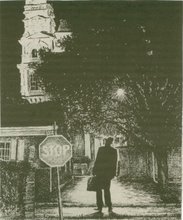I look up from my book to discover snow falling. The softly whirling flakes mute the lights from our neighbor’s house across Wonson Street, piling up on sidewalk and road, catching on window sills and empty flower boxes.
It’s early in December of my first year back from Italy. I’m living in my parents’ house again. For three winters I’ve seen no snow. When I go outside to move the car from our narrow street so the city’s snow plow can get through, I’m entranced by the curtains of white that fall across the windshield.
I continue up the Rocky Neck Causeway to East Main Street and over Point Hill, which connects with Main Street. I move past the intersection of Main and Prospect streets, heading down Union Hill, past Gorton’s 19th century redbrick office building, where my friend Jonathan Bayliss works. I’m alone. There are no cars on the street, nor are there any pedestrians.
The city is silent. The street lights illuminate the gradually drifting snow. The snow itself is feathery. Already several inches have accumulated, though I have no trouble driving through the storm. My Volkswagen, which I bought in September to commute to school, handles perfectly and I’m warm inside it.
I pass Gorton’s Seafood Center, where I worked packing frozen fish portions during the summer before I sailed for Italy. I’m now in the East End of Main Street next to the North Shore Theater, where I’ve seen most of the movies of my childhood. Looking through the glass front doors, I find the lobby empty; and as I drive past the Cape Ann Diner toward Brown’s Department Store I encounter no one. Not even the city plows are out.
Yet the snow continues to fall. Diagonally across Main Street from Browns’ and opposite Cameron’s Restaurant is the Hotel Gloucester, once the Chelsea, at whose bar I often stop for a drink on my way home from teaching high school English in Winchester.
All the stores are closed and Main Street is deserted. I drive through the West End, whose 18th and 19th century redbrick buildings are soon to be imperiled by Urban Renewal. And I turn left at the end of Main Street to enter the Fort section of Commercial Street, where Charles Olson lives with his wife Betty and son Charles Peter. As I drive past their apartment at 28 Fort Square, I can see the lights on in the top floor bedroom where Charles writes at a long table piled with manuscripts and copies of old town histories and court documents.
Olson’s friendship and that of Jonathan Bayliss, a Harvard and Berkeley educated novelist I’ve recently met, and poet Vincent Ferrini, whom I’ve known since I was fifteen, is the main reason I’ve chosen to remain in Gloucester. It’s comforting to me that Charles is at work high above the harbor as the snow thickens and one can hear the penetrating moan of the foghorn out beyond the Breakwater, visible from his windows. Soon I will be home in front of my own typewriter or writing in the ring-bound pages of the journal I’ve carried all over Europe.
I negotiate the narrow street of Fort Square, turning left at its end to return to Commercial Street, lined with fish processing plants, now closed for the night. The wharves behind them are tied with fishing vessels that will probably not sail before dawn if the snow keeps falling.
I continue along Rogers Street, which runs parallel with Main Street close by the waterfront and inner harbor. Again, there isn’t a soul on the street and my car is the only one out, though I think I finally hear the distant rumble of a snow plow. I drive past the Coal and Lumber Company, near Ivy Court and the Fitz Hugh Lane House, where my mother was born, returning to Rocky Neck along the route I’ve previously taken. The snow is thick on the ground now and the road more slippery; but I make my way easily up Union Hill, heading home again.
The street lights illuminate the houses along the way, their white clapboards and green shutters; and the snow renders the city timeless, blurring contemporary aberrations like asbestos shingles or aluminum siding, except for an occasional neon sign on the bars. It’s again the Gloucester of my childhood, and of my mother’s. As I drive back toward Rocky Neck along East Main Street past the old flake racks of Gorton’s, past the Beacon Marine Basin and Shores Wharf, where as high school students my brother and I spent Saturday afternoons reeling fish nets, I feel myself at home again.


No comments:
Post a Comment